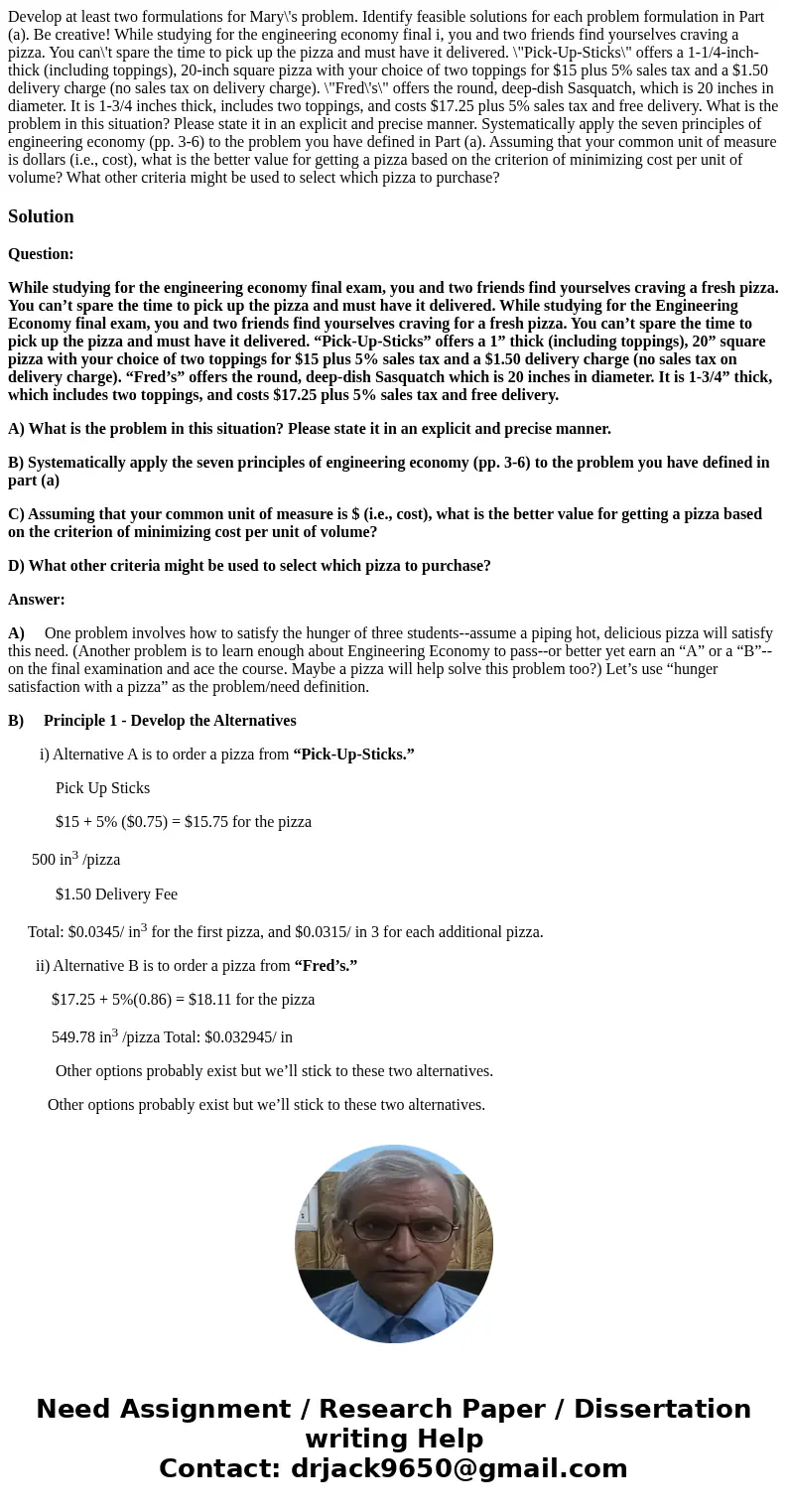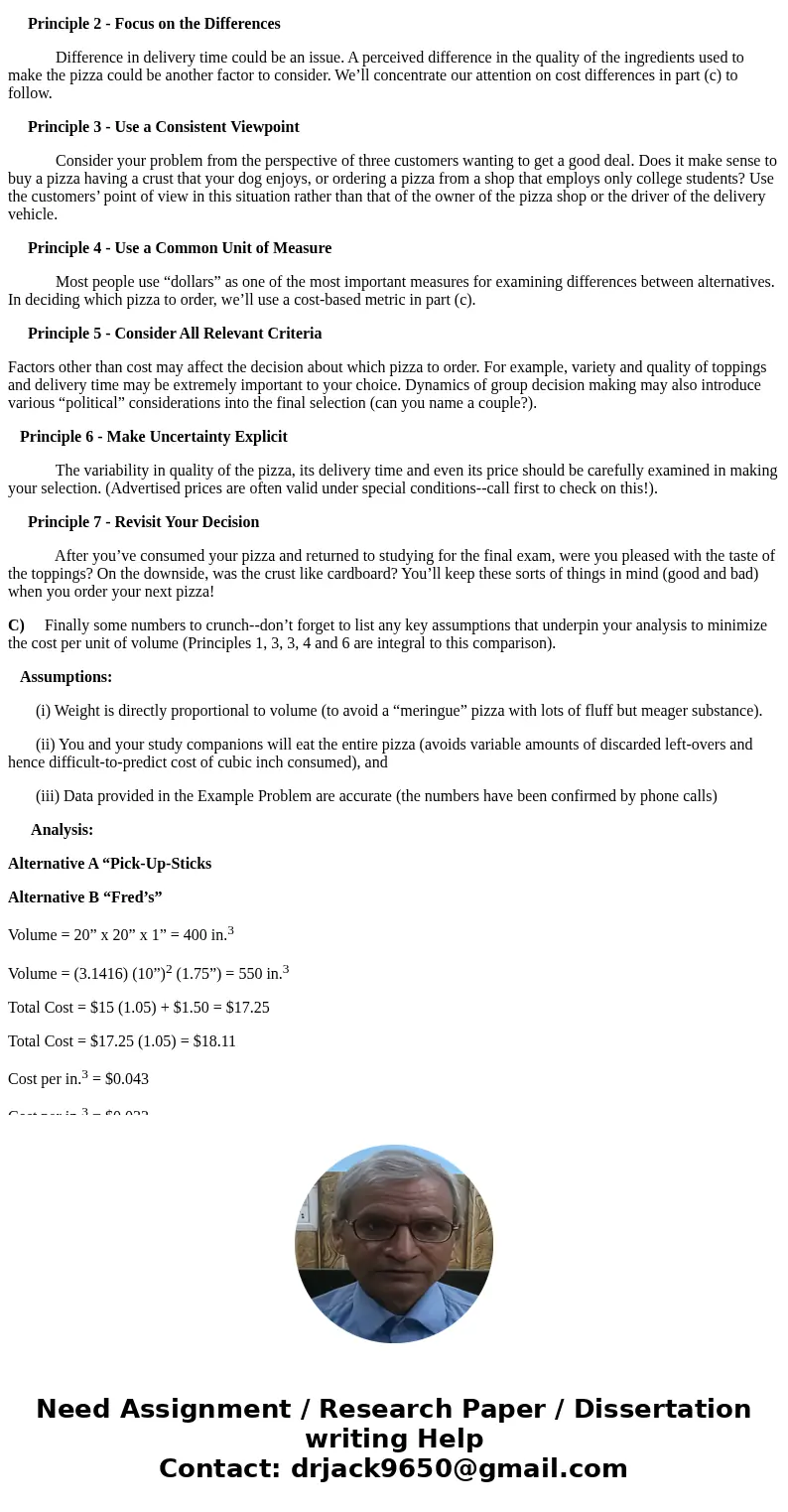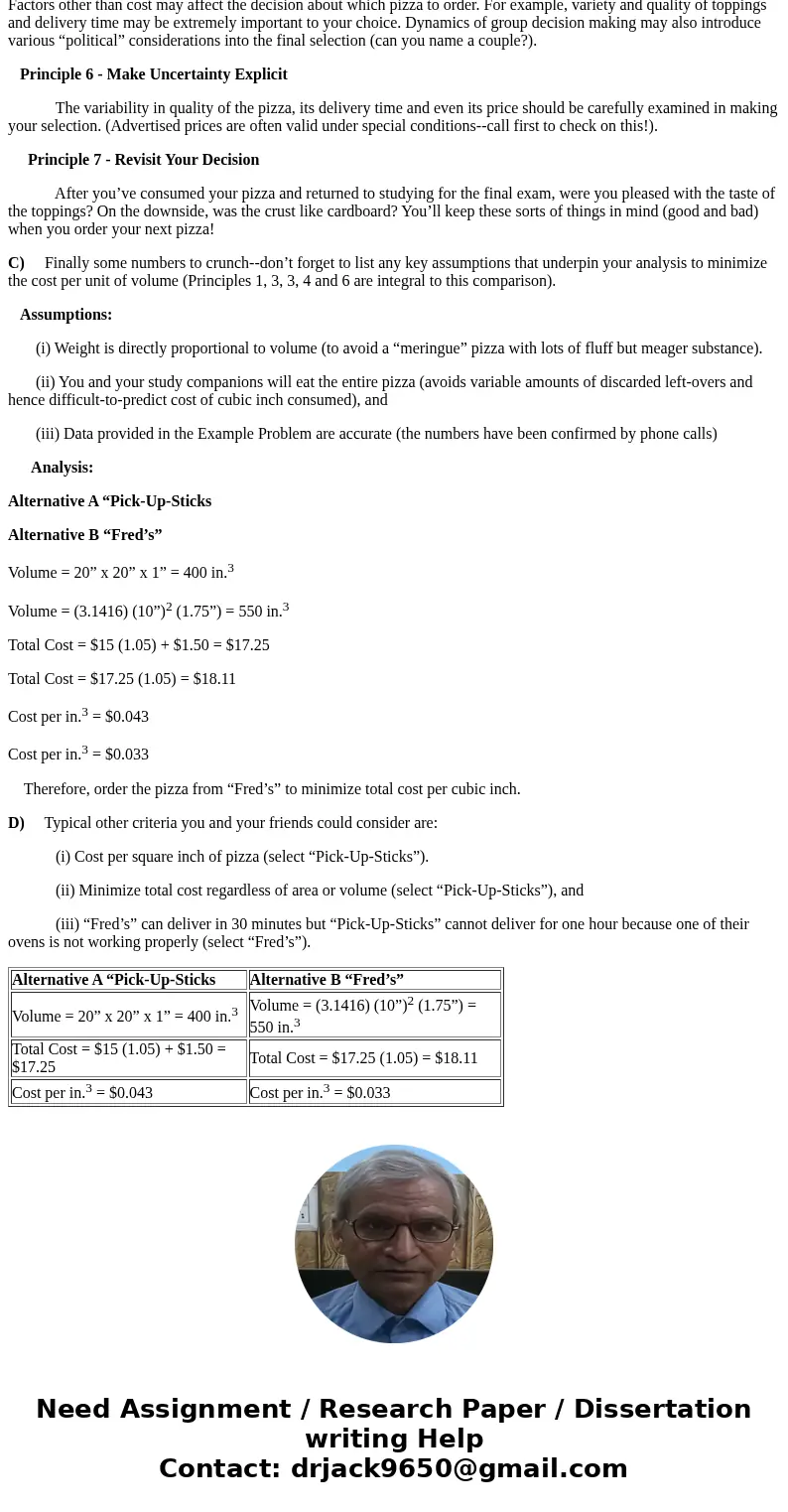Develop at least two formulations for Marys problem Identify
Solution
Question:
While studying for the engineering economy final exam, you and two friends find yourselves craving a fresh pizza. You can’t spare the time to pick up the pizza and must have it delivered. While studying for the Engineering Economy final exam, you and two friends find yourselves craving for a fresh pizza. You can’t spare the time to pick up the pizza and must have it delivered. “Pick-Up-Sticks” offers a 1” thick (including toppings), 20” square pizza with your choice of two toppings for $15 plus 5% sales tax and a $1.50 delivery charge (no sales tax on delivery charge). “Fred’s” offers the round, deep-dish Sasquatch which is 20 inches in diameter. It is 1-3/4” thick, which includes two toppings, and costs $17.25 plus 5% sales tax and free delivery.
A) What is the problem in this situation? Please state it in an explicit and precise manner.
B) Systematically apply the seven principles of engineering economy (pp. 3-6) to the problem you have defined in part (a)
C) Assuming that your common unit of measure is $ (i.e., cost), what is the better value for getting a pizza based on the criterion of minimizing cost per unit of volume?
D) What other criteria might be used to select which pizza to purchase?
Answer:
A) One problem involves how to satisfy the hunger of three students--assume a piping hot, delicious pizza will satisfy this need. (Another problem is to learn enough about Engineering Economy to pass--or better yet earn an “A” or a “B”--on the final examination and ace the course. Maybe a pizza will help solve this problem too?) Let’s use “hunger satisfaction with a pizza” as the problem/need definition.
B) Principle 1 - Develop the Alternatives
i) Alternative A is to order a pizza from “Pick-Up-Sticks.”
Pick Up Sticks
$15 + 5% ($0.75) = $15.75 for the pizza
500 in3 /pizza
$1.50 Delivery Fee
Total: $0.0345/ in3 for the first pizza, and $0.0315/ in 3 for each additional pizza.
ii) Alternative B is to order a pizza from “Fred’s.”
$17.25 + 5%(0.86) = $18.11 for the pizza
549.78 in3 /pizza Total: $0.032945/ in
Other options probably exist but we’ll stick to these two alternatives.
Other options probably exist but we’ll stick to these two alternatives.
Principle 2 - Focus on the Differences
Difference in delivery time could be an issue. A perceived difference in the quality of the ingredients used to make the pizza could be another factor to consider. We’ll concentrate our attention on cost differences in part (c) to follow.
Principle 3 - Use a Consistent Viewpoint
Consider your problem from the perspective of three customers wanting to get a good deal. Does it make sense to buy a pizza having a crust that your dog enjoys, or ordering a pizza from a shop that employs only college students? Use the customers’ point of view in this situation rather than that of the owner of the pizza shop or the driver of the delivery vehicle.
Principle 4 - Use a Common Unit of Measure
Most people use “dollars” as one of the most important measures for examining differences between alternatives. In deciding which pizza to order, we’ll use a cost-based metric in part (c).
Principle 5 - Consider All Relevant Criteria
Factors other than cost may affect the decision about which pizza to order. For example, variety and quality of toppings and delivery time may be extremely important to your choice. Dynamics of group decision making may also introduce various “political” considerations into the final selection (can you name a couple?).
Principle 6 - Make Uncertainty Explicit
The variability in quality of the pizza, its delivery time and even its price should be carefully examined in making your selection. (Advertised prices are often valid under special conditions--call first to check on this!).
Principle 7 - Revisit Your Decision
After you’ve consumed your pizza and returned to studying for the final exam, were you pleased with the taste of the toppings? On the downside, was the crust like cardboard? You’ll keep these sorts of things in mind (good and bad) when you order your next pizza!
C) Finally some numbers to crunch--don’t forget to list any key assumptions that underpin your analysis to minimize the cost per unit of volume (Principles 1, 3, 3, 4 and 6 are integral to this comparison).
Assumptions:
(i) Weight is directly proportional to volume (to avoid a “meringue” pizza with lots of fluff but meager substance).
(ii) You and your study companions will eat the entire pizza (avoids variable amounts of discarded left-overs and hence difficult-to-predict cost of cubic inch consumed), and
(iii) Data provided in the Example Problem are accurate (the numbers have been confirmed by phone calls)
Analysis:
Alternative A “Pick-Up-Sticks
Alternative B “Fred’s”
Volume = 20” x 20” x 1” = 400 in.3
Volume = (3.1416) (10”)2 (1.75”) = 550 in.3
Total Cost = $15 (1.05) + $1.50 = $17.25
Total Cost = $17.25 (1.05) = $18.11
Cost per in.3 = $0.043
Cost per in.3 = $0.033
Therefore, order the pizza from “Fred’s” to minimize total cost per cubic inch.
D) Typical other criteria you and your friends could consider are:
(i) Cost per square inch of pizza (select “Pick-Up-Sticks”).
(ii) Minimize total cost regardless of area or volume (select “Pick-Up-Sticks”), and
(iii) “Fred’s” can deliver in 30 minutes but “Pick-Up-Sticks” cannot deliver for one hour because one of their ovens is not working properly (select “Fred’s”).
| Alternative A “Pick-Up-Sticks | Alternative B “Fred’s” |
| Volume = 20” x 20” x 1” = 400 in.3 | Volume = (3.1416) (10”)2 (1.75”) = 550 in.3 |
| Total Cost = $15 (1.05) + $1.50 = $17.25 | Total Cost = $17.25 (1.05) = $18.11 |
| Cost per in.3 = $0.043 | Cost per in.3 = $0.033 |



 Homework Sourse
Homework Sourse